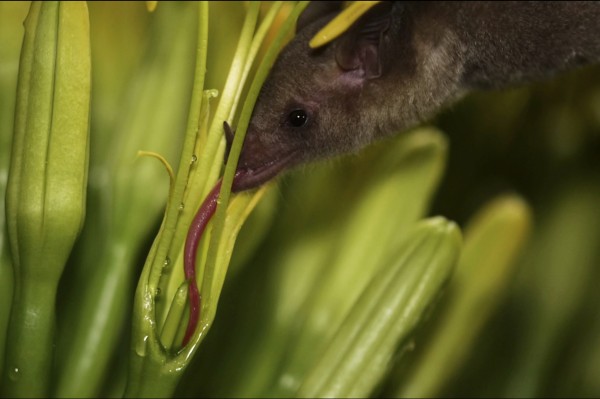FLAGSTAFF, Ariz. (AP) — Scientists have long suspected that Mexican long-nosed bats migrate through southeastern Arizona, but without capturing and measuring the night-flying creatures, proof has been elusive.
Researchers say they now have a way to tell the endangered species apart from other bats by analyzing saliva the nocturnal mammals leave behind when sipping nectar from plants and residential hummingbird feeders.
Bat Conservation International, a nonprofit group working to end the extinction of bat species worldwide, teamed up with residents from southeastern Arizona, southwestern New Mexico and west Texas for the saliva swabbing campaign.
The samples of saliva left along potential migration routes were sent to a lab at Northern Arizona University in Flagstaff, where researchers looked for environmental DNA — or eDNA — to confirm that the bats cycle through Arizona and consider the region their part-time home.
The Mexican long-nosed bat has been listed as endangered under the Endangered Species Act since 1988, and is the only one in Arizona with that federal protection. It is an important species for pollinating cactus, agave and other desert plants.
Officials from the U.S. Fish and Wildlife Service and the Arizona Game and Fish Department announced the discovery in late January. While expanding Arizona's list of bat species to 29 is exciting, wildlife managers say the use of this novel, noninvasive method to nail it down also deserves to be celebrated.
“If we were trying to identify the species in the absence of eDNA, biologists could spend hours and hours trying to catch one of these bats, and even then, you’re not guaranteed to be successful,” said Angie McIntire, a bat specialist for the Arizona's Game and Fish Department. “By sampling the environment, eDNA gives us an additional tool for our toolkit."
Every spring, Mexican long-nosed bats traverse a lengthy migratory path north from Mexico into the southwestern U.S., following the sweet nectar of their favorite blooming plants like breadcrumbs. They return along the same route in the fall.
The bat conservation group recruited ordinary citizens for the mission, giving them kits to swab samples from bird feeders throughout the summer and fall.
Inside the university lab, microbiology major Anna Riley extracted the DNA from hundreds of samples and ran them through machines that ultimately could detect the presence of bats. Part of the work involved a steady hand, with Riley using a syringe of sorts to transfer diluted DNA into tiny vials before popping them into a centrifuge.
Sample after sample, vial after vial, the meticulous work took months.
“There’s a big database that has DNA sequences of not every animal but most species, and so we could compare our DNA sequences we got from these samples to what’s in the database," Riley said. "A little bit like a Google search — you’ve got your question, you’re asking Google, you plug it into the database, and it turns up you’ve got a bat, and you have this kind of bat.”
Kristen Lear, of the conservation group, said the collection of eDNA has been used successfully for determining the presence of other kinds of wildlife in various environments, so the group proposed trying it with bats.
“They do apparently leave behind a lot of spit on these plants and hummingbird feeders,” Lear said.
___
ONeil reported from Las Vegas. Gabriel Sandoval, a corps member for the Associated Press/ Report for America Statehouse News Initiative, in Phoenix contributed to this report.




















